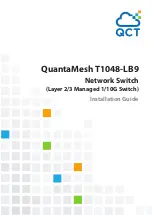
AT-8326GB Installation Guide
29
Telnet Application Protocol
Using the Telnet application protocol is another way for you to manage
the switch remotely from a workstation on your network. Starting this
type of remote access requires that you specify the IP address of the
switch in the Telnet protocol and enter “manager” as both the default
login name and default password.
SNMP Management
You can also manage a switch with an SNMP management program,
such as HP Openview. This management method requires loading the
AT-8326GB Fast Ethernet Switch MIBs into the SNMP management
program. The Allied Telesyn Enterprise MIB is available in the software
upgrades on the Allied Telesyn web site.
The standard MIBs supported by this switch include:
G
RFC 1213 (MIB II)
G
RFC 1493 (Bridge MIB)
G
RFC 1757 (4-Group RMON)
G
Allied Telesyn Enterprise MIB
Spanning Tree
Protocol (STP)
The AT-8326GB Fast Ethernet switch is IEEE 802.1D standard-compliant
and supports the spanning tree protocol. STP can be an important part
of large networks where loops exist in the network topology.
A loop occurs when two or more nodes on your network can transmit
data to each other over more than one link. Network loops can seriously
impact network performance because packets can become caught in
repeating cycles, often referred to as broadcast storms, that needlessly
consume network bandwidth and reduce network performance.
STP addresses this problem by ensuring that there is only one path
between the end nodes. Where multiple paths exist, STP places the extra
paths in a redundant or standby mode, leaving only one main active
path. The redundant paths can be activated by STP if the main path goes
down. So not only does STP guard against multiple links between end
nodes, but it also activates backup redundant paths in case a main link
fails.
STP is disabled by default on the AT-8326GB Fast Ethernet switch.
Note
The AT-8326GB Fast Ethernet switch supports only one STP
domain. All virtual LANs that you create will be members of that
STP domain.
















































